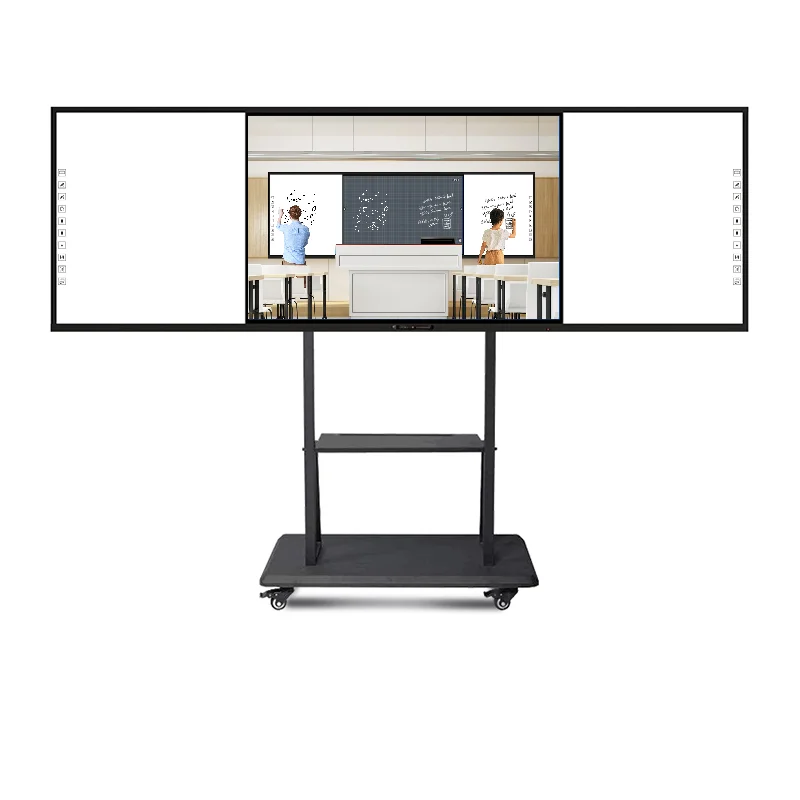For centuries, the traditional blackboard has been an iconic symbol of education. However, as technology continues to evolve, the face of modern classrooms is also changing. In this blog post, Orgscreen, a high performance education interactive flat panel exporter, will share the applications of recordable LED smart blackboard in K12 education.
Technical Overview
A recordable LED smart blackboard integrates several technologies to enhance traditional teaching methods:
- Surface Technology: Typically made from a durable, glare-free material, the surface of the smart blackboard allows writing with special pens that either use conductive ink or optical sensors.
- LED Backlighting: Integrated LEDs provide enhanced visibility, making writing or drawn figures stand out more clearly under various lighting conditions. Some models support dynamic backlight adjustments to reduce eye strain.
- Digital Capture and Recording: Embedded sensors track all writing and drawings in real-time, capturing them digitally. This information can be saved locally or uploaded to cloud storage for future access.
- Connectivity: Modern smart blackboards often support Wi-Fi, Bluetooth, or wired connections, enabling seamless integration with tablets, computers, and projectors. Some models feature USB ports and HDMI outputs.
- Software Integration: Accompanying software platforms allow educators to edit captured notes, share content with students, and integrate third-party educational apps.
- Touch Sensitivity: High-end models also incorporate multi-touch functionality, allowing for gesture-based interaction and collaborative work among multiple students simultaneously.
Applications of LED Smart Blackboard in K12 Education
1. Interactive Lessons and Immediate Feedback
Traditional blackboards limit interaction to visual display only, but a recordable LED smart blackboard enables real-time interactivity. Teachers can annotate digital documents, run interactive quizzes, and manipulate graphical elements live during the lesson. Students can participate directly on the board, receiving immediate feedback on their contributions.
For example, during a science lesson on ecosystems, students can physically drag species icons into appropriate habitats on the board, while the system records and analyzes their choices for later discussion.
2. Content Preservation and Review
One of the limitations of traditional teaching methods is the impermanence of handwritten content. The recordable feature ensures that every lesson, drawing, and annotation is saved digitally. Teachers can provide students with copies of board notes, which are particularly beneficial for those who need extra time to process information, were absent, or require revision material.
In mathematics, for instance, step-by-step problem-solving written during class can be revisited later, either during homework sessions or exam preparations.
3. Flipped Classrooms and Blended Learning Models
The integration of recordable smart blackboards is ideal for flipped classroom approaches, where instructional content is delivered outside of class and practice happens inside. Teachers can pre-record explanations, problem-solving processes, or discussions, allowing students to study at their own pace before engaging in hands-on activities in the classroom.
Similarly, smart blackboards complement blended learning models by offering both traditional chalk-and-talk methods and digital interactivity, catering to diverse learning styles.
4. Support for Special Education
Students with disabilities often face barriers in traditional classroom settings. Recordable LED smart blackboards can bridge some of these gaps. Larger fonts, high-contrast visuals, and audio recordings make content more accessible. Integration with text-to-speech and speech-to-text technologies further enhances inclusivity.
For example, a student with a hearing impairment can follow visual annotations while simultaneously receiving text-based summaries in real time.
5. Gamification and Engaged Learning
By enabling dynamic content manipulation, LED smart blackboards support gamification elements such as quizzes, puzzles, and competitions. This engagement strategy can significantly boost motivation, particularly in younger students.
A spelling bee competition, for instance, can be turned into a visual and interactive contest where students write words on the board, accumulate points, and receive instant feedback.

Advantages of Recordable LED Smart Blackboard
1. Enhanced Visual Learning
The combination of vibrant LED visuals and real-time content manipulation caters to visual learners. Complex diagrams in biology or dynamic equations in physics become easier to grasp.
2. Scalability and Flexibility
Smart blackboards can adapt to different teaching contexts—from small classrooms to large lecture halls—through screen sharing and projection capabilities.
3. Sustainable and Eco-Friendly
Reduced reliance on paper handouts and printed worksheets aligns with schools' sustainability goals. Also, because special pens used with smart blackboards are often refillable, there's less environmental waste compared to traditional whiteboard markers.
4. Data-Driven Insights
Captured lesson data can be analyzed to identify patterns in student performance, aiding personalized instruction and targeted interventions. Teachers can track which concepts were annotated most heavily, potentially signaling areas needing reinforcement.
Best Practices for Integration
1. Pilot Programs: Start with pilot projects in selected classrooms to identify practical challenges and gather feedback before a full-scale rollout.
2. Professional Development: Offer ongoing training sessions for teachers focusing not just on operational skills but also pedagogical strategies to maximize the smart blackboard's potential.
3. Inclusive Design: Select hardware and software that support accessibility features to cater to diverse student needs.
4. Curriculum Integration: Develop lesson plans that leverage the smart blackboard’s interactive capabilities rather than treating it as a glorified projection screen.
5. Community Engagement: Involve parents and the broader school community to foster support for the investment and ensure students can access recorded materials outside the classroom.
Future Outlook
As artificial intelligence (AI) and augmented reality (AR) technologies mature, future iterations of recordable LED smart blackboards will likely incorporate AI-driven tutoring, real-time language translation, and immersive 3D visualizations. These advancements could further individualize learning paths and expand global access to quality education.
Imagine a history class where students interact with a dynamically rendered 3D map of ancient Rome, or a physics class where gravitational waves are visualized and manipulated in real time—these scenarios are becoming increasingly achievable with the convergence of smart blackboard technologies and next-generation computing.
Conclusion
The recordable LED smart blackboard represents a significant evolution in educational technology. Its applications in K12 education promise to make learning more interactive, accessible, and efficient. However, its successful integration depends on strategic planning, ongoing support, and a commitment to inclusive practices. By thoughtfully embracing this technology, schools can enrich the educational experience and prepare students for a digitally interconnected world.
www.orgscreen.com
Orgscreen

More Stories
Lidi Toys Launches the Best Mini Soccer Goal for Kids: Perfect for Backyard Fun!
How To Choose The Right Fiber Discs To Achieve The Best Grinding Performance
Eco-Friendly Tobacco: A Greener Choice for Conscious Smokers